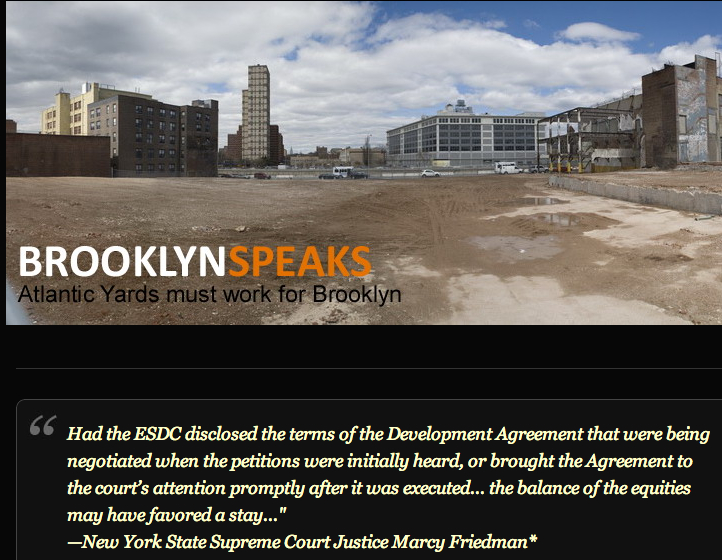State to Pay $300,000 to Lawyers Who Won Atlantic Yards Timetable Case
By Norman Oder November 26, 2013 1:00 pm
reprintsEmpire State Development, the state agency overseeing the Atlantic Yards megadevelopment in Brooklyn, has agreed to pay $300,000 in fees to lawyers representing two community coalitions that won a lingering lawsuit over the project’s timetable.
The lawyers successfully challenged the agency’s decision, in 2009, to extend the potential build-out of the project to 25 years, while only studying the impact of a five-year delay on a project long billed as taking 10 years.
 The fee is actually paid by Atlantic Yards developer Forest City Ratner, which, as is customary, agreed to pay for litigation, as well as an environmental review ordered by the state agency. The $300,000 represents about 83 percent of the sum requested by the attorneys.
The fee is actually paid by Atlantic Yards developer Forest City Ratner, which, as is customary, agreed to pay for litigation, as well as an environmental review ordered by the state agency. The $300,000 represents about 83 percent of the sum requested by the attorneys.
However it seems like a loss, the $300,000 may simply be the cost of doing business for Forest City, which, had a Supplemental Environmental Impact Statement been ordered in 2009 as the community groups requested, might have faced a stall in construction of the Barclays Center and thus continued massive losses on the New Jersey Nets, which at that point were owned mainly by developer Bruce Ratner and partners.
The winning petitioners were Develop Don’t Destroy Brooklyn, which fought Atlantic Yards, and a group of civic groups under the BrooklynSpeaks banner that have generally tried to mend the project rather than end it.
It is not typical for the prevailing party to get attorney’s fees; the state Equal Access to Justice Act awards such fees only when the state agency’s position is not “substantially justified. When state Supreme Court Justice Marcy Friedman ruled in September, Jeffrey S. Baker, attorney for Develop Don’t Destroy, said the decision “vindicates what the community has been saying for a long time. One can only wonder whether this project would have ever moved forward if, as Justice Friedman noted, the agency “disclosed the project’s true time line.”
ESD chose not to appeal Friedman’s decision on legal fees and settled after she requested the parties hash out the total via a referee. “ESD determined that this would be the best course of action to move the project forward,” spokeswoman Kay Sarlin Wright said last week. She confirmed that the agency, not the developer, made the decision.
ESD still seems to be cooperating with the developer, as the SEIS ordered by Friedman, and upheld in 2012, to study the impact of a 25-year project build-out is moving slowly. While a preliminary document, a draft scope of work, was issued December 2012 and a public hearing held last February, no final scope, a prelude to a Draft SEIS and later a Final SEIS, has been released, 10 months later.


